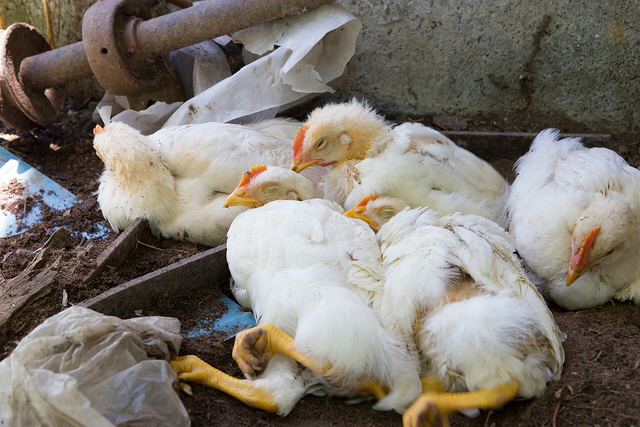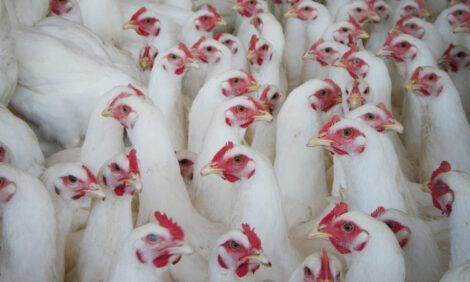



Questions and Answers on Highly Pathogenic H5N8 Avian Influenza
A summary of current knowledge on the H5N8 highly pathogenic avian influenza virus from the World Organisation for Animal Health (OIE).
What is Avian Influenza (AI)?
Avian influenza (AI) is a disease of birds, caused by Type “A” influenza viruses which can affect several species of domestic poultry, such as chickens, turkeys, quails, guinea fowl, ducks, etc., as well as pet birds and wild birds.
Avian influenza viruses have also been isolated, although less frequently, from mammalian species including rats, mice, weasels, ferrets, pigs, cats, tigers, dogs, horses, as well as humans.
What is the meaning of low pathogenic/highly pathogenic?
There are many strains of AI viruses that can generally be classified into two categories according to the severity of disease in poultry:
- low pathogenic (LPAI) that typically causes little or no clinical signs in birds
- highly pathogenic (HPAI) that can cause severe clinical signs and possible high mortality rates in birds.
The differentiation between low and high pathogenicity avian influenza is based on the results of laboratory tests, which are described in the OIE Diagnostic Manual.
This characterisation of avian influenza viruses as low or high pathogenicity (severity of disease) is specific to poultry and other birds, and not necessarily to other species that can be susceptible to avian influenza viruses including humans.

What is influenza A (H5N8)?
This virus was detected early this year in Asia in poultry species in the Republic of Korea, Japan and in China. In January 2014, the authorities of the Republic of Korea reported the first poultry cases of disease due to the infection with a highly pathogenic strain H5N8 of avian influenza viruses (type A).
The total of 29 outbreaks was reported in birds involving geese, chickens and ducks. Close to 600,000 birds were culled. This event was resolved in September 2014.
In September 2014, the country reported a new outbreak in ducks reared for meat production where 1200 birds died and 19,800 were culled to control the disease.
In April 2014, Japan notified one outbreak caused by HPAI H5N8 with 1,100 cases reported. As a part of control measures, 112,000 birds were destroyed/culled. This outbreak was resolved in July 2014. Four months later, in November 2014, another outbreak was notified by Japan when the virus was confirmed from two faecal samples taken from tundra swan (Cygnus columbianus).
China reported the same sub-type of avian influenza viruses in October 2014 notifying two outbreaks involving one environmental sample and one duck sample collected as a part of the national surveillance plan.
H5N8 virus was previously seen in the United States of America (Idaho) in 2008 in the form of low pathogenic avian influenza and then six years later (2014) in California in a similar LP form.
German authorities confirmed highly pathogenic H5N8, in fattening turkeys in a semi-closed rearing system in Mecklenburg-Vorpommern in early November. One case was detected; all 1,731 susceptible birds present at the farm were destroyed.
Nine days later, veterinary services of The Netherlands detected the virus within the farm of 150,000 layer and breeding hens in Utrecht in a closed breeding system. There were 1,000 cases confirmed; all susceptible animals on the infected premises have been killed.
The United Kingdom also detected a highly pathogenic HPAI virus subtype H5N8 in a housed 60-week-old duck breeding flock that started about same time as in Netherlands. Approximately 6,000 birds has been culled.
These data are extracted from WAHIS, the OIE World Animal Health Information System.
What is the source of influenza A (H5N8)?
Based on the partial sequence data of the HA gene segment, the German, the Dutch and the British viruses were identified as closely related to the Republic of Korea H5N8 viruses. Investigations are continuing to determine the source. The viruses belong to the clade 2.3.4.6.
Have wild birds been identified as a carrier of the influenza A (H5N8) virus?
Wild birds can normally carry avian influenza viruses in their respiratory or intestinal tracts but they do not commonly get sick. They have historically been known as reservoirs and vectors of AI viruses. Around the world, surveillance measures have been put in place to monitor occurrence and characteristics of AI viruses in wild birds.
To date, the infection with avian influenza viruses subtype H5N8 has been detected in wild birds in China1, the Republic of Korea2 and Japan3. The majority of avian influenza viruses does not cause disease in wild birds but is very likely that wild birds might spread the virus via their migratory flyways.
How is influenza A(H5N8) transmitted and spread among birds?
All AI viruses can be transmitted among birds through direct contact with secretions from infected birds, especially faeces or through contaminated feed, water, equipment, and human clothing and shoes.
They are readily transmitted from farm to farm by the movement of domestic live birds, people (especially when shoes and other clothing are contaminated), and contaminated vehicles, equipment, feed, and cages. Highly pathogenic viruses can survive for long periods in the environment, especially when temperatures are low.
Several factors can contribute to the spread of all AI viruses including: the movements of people and goods, marketing practices (live bird markets), farming practices and the presence of the viruses in migratory wild birds.
What are the reporting requirements for influenza A (H5N8)?
As detailed in the OIE Terrestrial Animal Health Code, all cases of highly pathogenic avian influenza (HPAI) found in any domestic or wild bird must be notified to the OIE by the competent authorities (Veterinary Services) in a country.
Low pathogenic avian influenza viruses of subtypes H5 and H7 in poultry are also notifiable to the OIE because, even though they do not cause severe disease, they have the potential to mutate readily into highly pathogenic viruses or to infect other species.
What are the basic requirements for worldwide AI prevention and control in animals?
All countries must maintain the public and private components of Veterinary Services, which comply with OIE standards on quality, including:
- Appropriate legislation
- Early detection and response capacities in face of biological events in animals
- Compensation mechanism establishment and management
- Efficient veterinary laboratories
- Use of vaccination in relevant epidemiological situations when appropriate.
Can culling be used as a control measure?
If the infection is detected in animals, generally a culling policy is used in the efforts to control and eradicate the disease.
Requirements include (and are described in the OIE Terrestrial Animal Health Code):
- humane destruction of all infected and exposed animals (according to OIE animal welfare standards)
- appropriate disposal of carcasses and all animal products
- surveillance and tracing of potentially infected or exposed poultry
- strict quarantine and controls on movement of poultry and any potentially contaminated vehicles and personnel
- thorough decontamination of infected premises
- a period at least 21 days before restocking.
Culling of infected and susceptible domestic birds has been carried out by currently affected countries with respect to highly pathogenic H5N8.
What are the OIE recommendations for trade in poultry from a country infected with influenza A (H5N8)?
The risk analysis to be used by importing countries in order to protect their territory from pathogens introduction is very complex and is based on a long list of OIE standards.
In the case of outbreaks of high pathogenic avian influenza of the H5 strain in potential exporting countries, the trade recommendations that apply can be found in the OIE Terrestrial Animal Health Code (Chapter 10.4; 2014). These measures are science-based and should not result in unjustified trade barriers; they include zoning and the testing of the animal populations of origin.
What compensation measures should be applied for affected farmers?
Systems for financial compensation of farmers and producers who have lost their animals as a result of mandatory culling requested by national authorities vary around the world; they may not exist at all in some countries. The OIE encourages national authorities to develop and propose compensation schemes because they are a key to early detection and transparency in reporting the occurrence of animal diseases, including avian influenza.
What are the food safety recommendations?
Animals which have been culled as a result of control measures in response to an outbreak of avian influenza, including the A (H5N8) virus, should not enter the food and feed chain as a precautionary and regulatory measure.
There is no evidence to suggest that the consumption of poultry meat or eggs could transmit the AI virus to humans.
What is the public health risk associated with avian influenza?
AI viruses are highly species-specific, but have, on rare occasions, crossed the species barrier to infect humans. This disease should not be confused with seasonal human influenza (flu), a very common human disease (generally caused by human H1 and H3 viruses). Transmission of AI viruses to humans occurs when there is close contact with infected birds or heavily contaminated environments.
Currently, there is no evidence of human infection from influenza A(H5N8) virus.
What prevention measures are recommended at the farm level?
It is essential for poultry producers to maintain biosecurity practices to prevent introduction of the virus in their flock:
- keep poultry away from areas frequented by wild fowl
- do not provide elements on property that may attract wild birds
- keep control over access to poultry houses by people and equipment
- maintain sanitation of property, poultry houses and equipment
- avoid the introduction of birds of unknown disease status into flock
- report illness and death of birds to Veterinary Services
- appropriate disposal of manure and dead poultry
- vaccinate animals when appropriate.
More information is available from OIE:
- OIE Terrestrial Animal Health Code
- OIE Manual of Diagnostic Tests & Vaccines for Terrestrial Animal
- OIE Technical Disease Card
- OIE web portal on avian influenza
- OIE/FAO Network of expertise on animal influenza (OFFLU)
References
- Fan S., Zhou L., Wu D., Gao X., Pei E., Wang T., Gao Y., Xia X. 2014. A novel highly pathogenic H5N8 avian influenza virus isolated from a wild duck in China. Influenza Other Respir Viruses. 2014 Nov 1. doi: 10.1111/irv.12289
- Ku K.B., Park E.H., Yum J., Kim J.A., Oh S.K., Seo S.H. 2014. Highly Pathogenic Avian Influenza A(H5N8) Virus from Waterfowl, South Korea, 2014. Emerging Infectious Diseases 20(9):1587-1588. doi:10.3201/eid2009.140390.
- WAHID
November 2014











